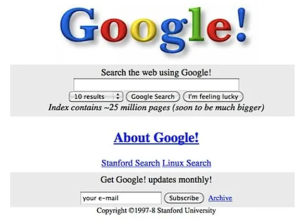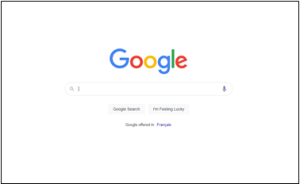3.1 Search Engines
Search engines, in particular Google, have become tools trusted by society. When looking for an answer to a question, people Google it and assume the results page will be filled with reliable information. Because of this unchallenged faith, programmers of search engines have become the gatekeepers to and the organizers of vast amounts of information. Should these companies be trusted blindly? Consider the fact that most who use search engines don’t understand how they work. It would require a lot of learning about computer programming to reach a minimal level of understanding of the various technologies involved (Noble, 2018). Let’s examine, at a basic level, how search engines and algorithms work.
3.1.1 The History of Search Engines
A web search engine is “a software program that searches the Internet (bunch of websites) based on words that [users] designate as search terms” (Seymour, et al, 2011, p. 1). The history of search engines encompasses decades of programming, algorithm creation, competition and major profits. People began inventing search engines in the early 1990s, and at that time they were difficult to use. The first known search engine, called Archie, made its appearance in 1991. Its developers created an index of file names and website titles. To find a website an individual had to type the exact title of the file or webpage into the search box. Keyword searching (Scanning an entire website for specific words) and natural language searching (Using sentences and questions to search rather than just keywords) did not yet exist (Seymour et al., 2011). At this time, search engines were used mostly by computer programmers and those in the tech industry. In 1994, WebCrawler became the first well-known, public search engine that could perform keyword searching within a webpage (Seymour et al., 2011). Yahoo!, also created around this time, incorporated both browsing and searching capabilities. Alta Vista, launched in 1995, was the first to incorporate natural language into its search capabilities (Seymour et al., 2011).
| Bolded search engines still exist today! | |
|
Year |
Search engine |
|
1992 |
Veronica |
|
1993 |
Jughead |
|
1994 |
Yahoo |
|
Infoseek |
|
|
Webcrawler |
|
|
1995 |
Alta Vista (purchased by Yahoo) |
|
1996 |
Backrub (the original Google) |
|
Ask Jeeves / Ask.com |
|
|
1998 |
MSN Search (becomes Bing in 2009) |
|
|
|
As new search engines were released, the battle began to become number one and corner the market on advertising profits. The search engines we still use today (Yahoo, Ask.com, Bing and Google) became the clear front runners with Google quickly becoming the most popular search engine after its release in 1998 (Seymour et al., 2011). Over time, algorithms and design have both evolved, but in many ways, the engines of the early 90s are reflected in their current versions.




3.1.2 How do Search Engines Work?
Being the most used worldwide, this section will focus on Google Search, which has continued to evolve and change since its creation. Google’s founders claim to have won the search engine wars because they created an algorithm that searches like a human by using natural language and prioritizing the results that are most relevant (StatCounter, 2022). When it first emerged, Google Search ranked the popularity of a website based on how many other pages link to that website (Seymour et al., 2011). This, according to Google’s founders, provides users with reliable results (Hooker, 2016; Press, 2016; Heitzman, 2017, Special to the Denver Post, 2013). Since day one, the company has been mapping hundreds of millions of websites and placing them all into a central location called an index. When a user searches for something (for example, pizza), Google’s ranking system tries to figure out what they are looking for using various factors such as location, past searches, and more. Once Google Search identifies what it thinks the searcher is looking for, it assembles a results list with the pages most relevant to the search.
Google also claims that their professionals spend a great deal of time adjusting the algorithm to recognise scam sites. For instance, a website might assume that people will frequently search for ‘pizza’ and use a search for the word to lure a person into landing on their webpage. How? They might create a webpage that repeats the word pizza nonsensically and in multiple places making it rank higher in people’s searches. This will happen because, with all the mentions of pizza, the webpage looks like it is a good fit for the search. In this case, the scam site gains clicks which might result in profit or might enable them to put a virus on the searcher’s device, and the searcher is not finding their desired results. Google (2019b) claims that when they find scam sites like this, they delete them from their index. Bing also tries to protect its users from scams by labeling websites that contain harmful content. Links to these pages are removed from search results but the website is still listed “to give you both relevant and safe results” (Microsoft, n.d., para. 4). All of these efforts, to eliminate or add tags to certain sites, are a part of the search engine’s algorithm.
The specifics of how algorithms function are often kept secret because companies want to protect their intellectual property. A good search engine algorithm can lead to major advertising income, recall the discussion about Google taking vast amounts of profits from the news industry. They owe this success to the popularity of their algorithm (Brisson-Boivin & McAleese, 2021). It is important to keep in mind that “Google Search is an advertising company, not a reliable information company” (Noble, 2018, p. 5).
The act of scanning an entire website for specific words.
The ability to use sentences and questions to search rather than just keywords.
The central location where Google maps hundreds of millions of websites that have existed since the beginning of Google.

